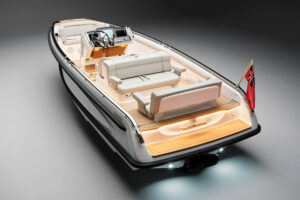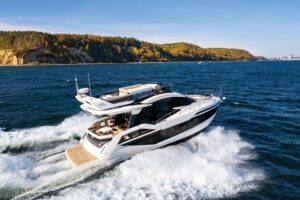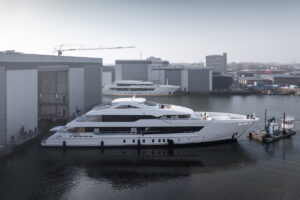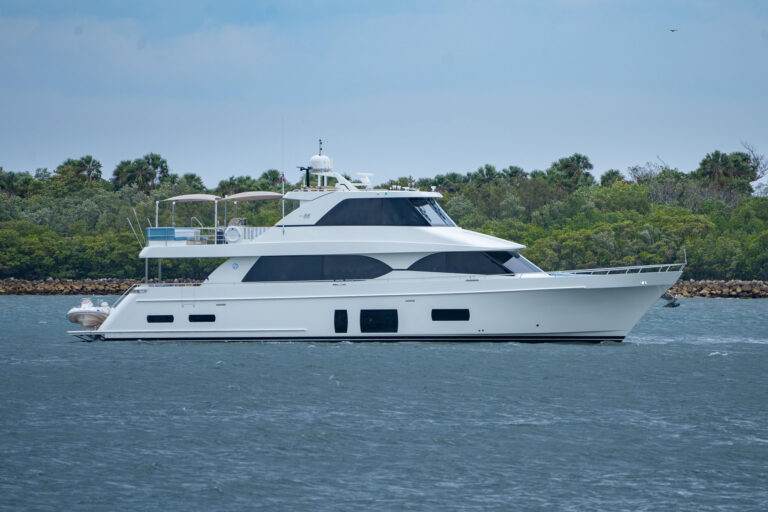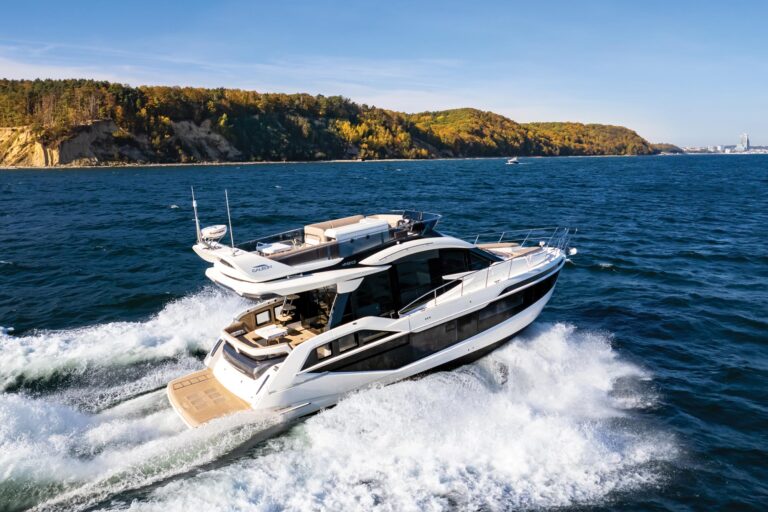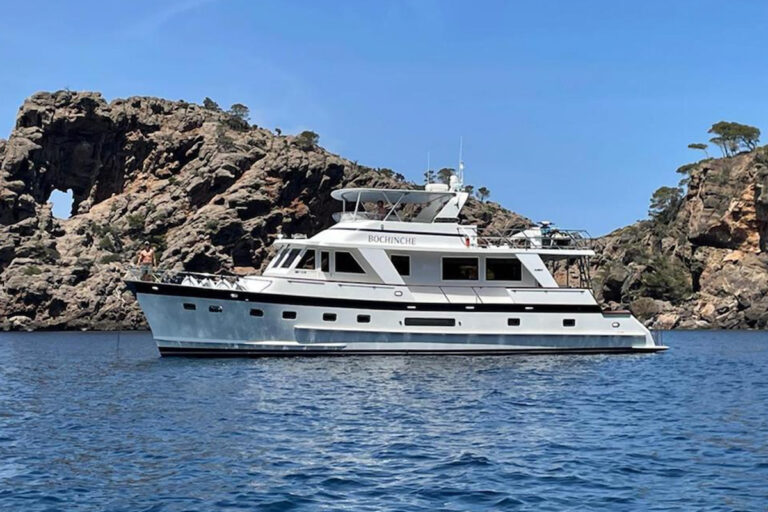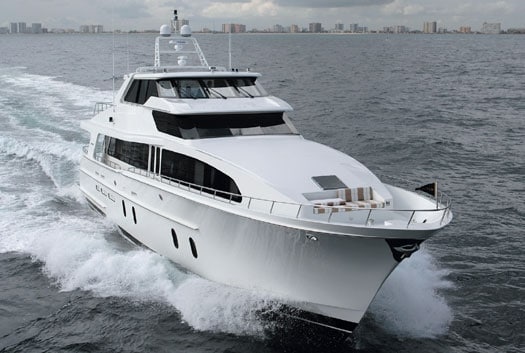
Cheoy Lee 95
It was one of those days when you would really rather not be at sea. Squalls had rolled through Ft. Lauderdale earlier that morning and the strong northerly had turned the north-flowing Gulf Stream into rows of square-edged holes. As we cleared the harbor and the bow of the new Cheoy Lee 95 rose to the first sea, owner David Sale turned to his captain, Kent Kohlberger, and asked, “How big you figure?”
Kohlberger eyed the seas a moment and replied, “Maybe four to five.” Then the bow went over the swell and dropped into a deep trough, tossing spray to each side. “Or more,” he amended.
This was a real sea trial, not one of those smooth-water cruises. And the 95 was showing her seaworthy breeding. The owner, the captain and the representatives from Cheoy Lee were all smiling. Sure, the props were a bit wanky: easily cured. But the technicians aboard to test the autopilot found it tracked impeccably even in quartering seas, and the Naiad stabilizers kept her as steady as a lighthouse. She punched into the head seas with aplomb and, surfing down-sea, tracked with fingertip adjustments.
The Cheoy Lee 95 is the latest in the 135-year legacy of this Far East builder, where literally generations of the same families have refined their skills while adding new technology. For decades, Cheoy Lee has been synonymous with Hong Kong, but the 95 is one of the first to be built at the new state-of-the-art shipyard in Doumen, China.
She is also the first launch from the new pairing of Cheoy Lee with naval architect M.G. Burvenich, and it’s clearly a comfortable match. Burvenich had worked in the Fexas design office on previous Cheoy Lee projects; now on his own, he’s stamped the yacht with his imprimatur.
The most obvious difference is the absence of the typical Fexas sheerline forward with its drooping clipper bow. Instead, the new 95 has upswept bulwarks surrounding the foredeck and a stainless steel handrail that rises subtly to give an even higher effect. There’s no question that the designer had to push the cabin house far forward in order to accommodate the on-deck master suite, but the proud bow defuses any appearance of being heavy.
The most unusual feature of this 95 is the “non-pilothouse” pilothouse in between the saloon level and the enclosed flybridge. In profile, the 95 looks like a typical raised-pilothouse motoryacht but, in fact, the usual lower helm has been turned into a comfy lounge with a curved sofa, wide table and a great view through the forward windows. You can opt to have Cheoy Lee install a helm here but, with an enclosed flying bridge just steps away, why bother?
Besides, this “observation lounge” is a great place to watch the world go past. You’re close to the galley, amidships for minimum motion and protected from wind, spray, heat or cold. David Sale and I settled into the deep leather cushions; Sale grinned and said, “I’m gonna like this.”
Sale is a yacht broker’s dream. “I saw the 95 at the Fort Lauderdale Boat Show, walked through her at six o’clock, and bought her at six forty-five. ‘Course, then I had to call Bernice to tell her what I’d done,” he says with a wink. “But she was good with it.”
Bernice Sale probably had a pretty good idea what her husband, an automobile dealer and former owner of a race-car team, had in mind. Although the couple had been away from the water for five years, they’d owned a Cheoy Lee 81 before that.
This 95 had been built as a spec boat but, unlike many plain-vanilla spec boats designed not to offend potential buyers, had been given a warm and inviting look by interior designer Lisa Pirofsky. With raised mahogany paneling, it is reminiscent of a fine men’s club.
In the airy saloon, windows extend down to the couch tops for a great view; spacious areas are delineated by dividers and ceiling treatments. A curved couch to port faces a big TV, while a formal dining area for eight is forward, past a columned pony wall behind the couch. The starboard side of the saloon has barrel chairs, and the dining area includes a wet bar-a nice touch.
While many yacht designers hide the stairs to the lower accommodation deck, the Cheoy Lee turns them into a powerful element with a wide center-line staircase leading down between elegant wrought-iron banisters with mahogany handrails.
But before you head for the lower deck, walk forward past the observation lounge to the L-shaped galley that is fully enclosed and has a separate entrance directly to the dining room as well as the starboard corridor. The galley is fitted to commercial standards with GE Profile stainless steel appliances and ample granite counters, and large windows to port give the chef a view.
Just forward is one of the two “master suites,” and it’s going to challenge each owner to decide which is the best. The split-level upper master benefits from the same oversized windows as the saloon, with views from the centerline king-sized berth; the master head is on a lower level forward, with a large shower and twin vanities.
If you take the stairs down from the saloon and pass through the lower foyer (with hidden washer/dryer), you’ll sweep directly into the lower master, with a vanity to starboard, loveseat to port and a spacious head with mahogany columns, spa tub and separate shower as well. My choice would be the lower suite, since it’s full beam (the upper is the beam minus side decks) and has more amenities (sofa, spa tub, etc). I think the Sales will also choose the single-level lower suite for a simpler reason: “My knees hurt,” says Sale.
Aft of the foyer is a pair of nearly identical double cabins, each with the same finish of marble and leather and warm mahogany. A thoughtful feature is the presence of an emergency exit in each cabin: The two after staterooms have access through closets to the engineroom and stern, while the upper master has a clever rolling ladder to a deck hatch. Crew quarters are aft, with the double captain’s cabin to starboard and twin-bunked crew quarters to port, each with private heads and showers.
It’s going to be a tough choice for guests whether they choose to congregate in the observation lounge or the enclosed pilothouse, which has the added attraction of a sofa and television, plus being able to watch the crew at work on the raised helm area. Just outside the sliding doors is a spa with wrap-around bar, a barbecue and another couch, all semi-protected by the pilothouse overhang. The boat deck easily handles a 15-foot Novurania with a Nautical Structures 1,700-pound crane.
Standard power is a pair of Caterpillar C32 diesels of 1,652 hp each, in an engineroom designed for efficiency. A pair of Northern Lights 40kW gensets provides electrical power, while the Naiad 42 hp bowthruster and the steering are hydraulic.
Underway, the 95 was pleasant even in unpleasant conditions. Sale grinned widely when the captain announced that we were getting 13 knots at 1300 rpm upwind, and he grinned even more when we turned down sea and hit 16 to 17 knots at the same rpm. Solid and stable, the 95 was unfazed by the Gulf Stream seas.
As I debarked later, I shook Sale’s hand and told him I thought he had made a really good choice. “I know,” he said happily.
Contact: Cheoy Lee; (954) 527-0999; www.cheoylee.com

